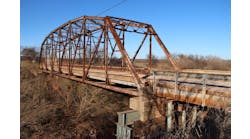By: Bill Wilson
Two thousand is a nice number, which is why it is losing badly in its fight with 61,000.
Nice does not come with a whole lot of muscle. Consequently, the quest to make significance progress on the nation’s structurally deficient bridge list continues to be a struggle.
According to the latest data from the Federal Highway Administration (FHWA), there are over 61,000 structurally deficient bridges in the U.S.—about 2,000 fewer than in 2013. It’s progress, but the type you get while climbing slow up the down escalator.
“Structurally deficient bridges have been going down slowly over time,” Alison Black, chief economist for the American Road and Transportation Builders Association, told Roads & Bridges. “We lower it by about half a percent every year. It’s very slow. It would take about 20 years to cut that number in half.”
And the number of bridges the FHWA tracks does not reflect the true sense of urgency industry wide. According to a recent Roads & Bridges survey completed by government officials at all levels, the number of structurally deficient bridges has been on the rise for the last three years. Just over 35% of respondants said the structurally deficient list in their state is on the rise, up more than a point from 2014 and over 6 points from 2013. Even more concerning is the constant rise of functionally obsolete bridges. The latest R&B data indicates that number is showing an upward trend as well—26.7% of government officials said they are on the increase in 2015 compared to 20.9% two years ago.
There is a chance the numbers will get worse. The average age of a bridge in the U.S. exceeds 43 years old, and many were designed to last only 50 years. Funding shifts also could turn the situation more severe. ARTBA said states have been more committed to addressing their bridge problem the last couple of years, but at the expense of pavement management. The money is expected to favor roads in the near future.
The reprioritization of funds, however, could be a non-issue if Congress finally passes a long-term highway bill, if more is done at the state and local level or, ideally, if there is a combination of both.
California, Minnesota, Pennsylvania, Ohio, Massachusetts, Connecticut, Washington, New Jersey, Oklahoma, Vermont, Rhode Island, New Hampshire, and Texas have all focused more on their bridge network over the last few years, but according to the R&B bridge survey less funding is becoming available (37.7% of respondents say money has decreased in 2015 vs. 32.1% in 2014) at the federal, state and local levels.
“You think about how local governments have been squeezed and it’s no wonder we have seen over 650 state and local ballot initiatives over the last six years because they are trying to address some of these concerns,” said Black.
“But when you look at the percentage of contract awards and the percentage of value in place for bridge and highways we tend to see a bump up in bridge work following the passage of a federal aid bill.”
Not in the public interest
The U.S. Public Interest Research Group (U.S. PIRG) on transportation believes some states could be doing more with what they have when it comes to repairing their bridge system.
The U.S. PIRG did it’s own analysis of the 2014 FHWA bridge data and listed its top 10 states where structurally deficient structures are growing. Alabama, Arizona, Louisiana, Mississippi, Montana, Oregon, Rhode Island, Washington, West Virginia and Wisconsin all added to their SD list over the last year; Montana led the way with 25.
“We look at transportation solutions for the country and we see this as a pretty clear sign of skewed spending priorities in states where there are successive years of increases in structurally deficient bridges,” John Olivieri, 21st Century Transportation campaign director for U.S. PIRG, told Roads & Bridges, “and then there are any number of atrocious highway projects in these states that [also] are sucking up massive amounts of funding.”
A prime example, according to the U.S. PIRG, is Louisiana. Since 2011, the state has added 187 to its structurally deficient bridge list, and in 2014 62% of funding was devoted to highway expansion.
“Oftentimes it turns out that these highways aren’t justified by driving volume, and the cost it would take to build them is prohibitive for any investment in repairing bridges or investments in high-speed rail or expanding public transit,” said Olivieri.
David Miller, structures and facilities maintenance engineer for the Louisiana Department of Transportation and Development, was not sure how to respond to Olivieri’s claim.
“We’re spending a good amount of money in bridge preservation,” he told Roads & Bridges. “I don’t see a lot of new [road projects] going on, so I don’t know what they are talking about. I don’t know what they mean by that.”
Louisiana’s bridge network is one of a kind, which changes the game when you are talking about maintenance and preservation. According to Miller, the state is No. 3 in the U.S. in total sq ft of deck area, No. 3 in the number of timber bridges and No. 1 in the number of movable bridges, which stands at 150. “Those require a tremendous amount more maintenance than a fixed bridge,” said Miller.
Louisiana’s bridge preservation budget also has received slight increases, and more is being done. Miller said bridge washing is on the rise in an effort to remove road salt on structures in the northern portion of the state. Bridge inspection also has been amped up as staffs have been increased and more equipment has been purchased. Louisiana’s bridge management has been digital since 2007, but Miller said there will be a switch over to Bentley’s InspecTech, which will allow personnel to use iPads out in the field.
“We are trying to get out in front of these bridges,” Miller said. “I think the inspection program is really running well so we are finding issues and problems that cause the bridges to be structurally deficient, but a big part of it is age.
“The majority of our infrastructure is in the 50- to 60-year-old age range.”
An effort to keep up
Michigan also is in the midst of nursing a rather large community of senior bridges. About 11% are structurally deficient, and weight-restriction postings are on the rise.
“We have some concerns out there in terms of funding and getting stuff up to par, but there is nothing we can’t manage right now,” Corey Rogers, engineer of Bridge Building Services for the Michigan DOT, told Roads & Bridges. “You can only do so much before you eventually fall behind.”
Michigan’s annual budget for bridge repair is currently $186 million, a number that has not changed since the late 1990s, according to Rogers. However, like Louisiana, Michigan has taken its inspection program to another level. The state is divided into seven different regions, with each region supporting its own bridge engineer, who then determines what is needed in terms of maintenance and repair.
“The guys who run that do a fantastic job with keeping up,” he said.
The bridge management system also was recently consolidated, as the Michigan Bridge Inspection System and Michigan Bridge Management System are now known as MiBridge, a one-stop shop for inspection and management needs. The Michigan DOT also is currently involved in a research project with Michigan Tech University for wireless data accumulation. The system allows users to do element-based inspections with a smart device or tablet. Currently, field personnel use tablets, but nothing is connected to MiBridge. Rogers hopes that will happen within the next year.
The Michigan DOT recently placed a major bridge on the structurally deficient list—the I-75 Bridge (115,000 vehicles in average daily traffic) over the Rouge River in Detroit—in April. Due to a lack of funding, it will take two years to replace the bridge deck, which is the sole cause of the poor rating. Rogers said the superstructure and substructure were still in good shape. Crews have been doing fast-set, full-depth patching on the deck three or four times a year.
Proposition 1, which called for a 1% state sales tax increase, was on the ballot in early May and would generate $1.25 million annually so that structures like the I-75 Bridge could be taken off the structurally deficient list sooner.
If the measure is defeated, the Michigan DOT will continue to thrive on innovation to stretch the dollars that are available. An accelerated bridge program (ABC) was launched last year, and another ABC project is scheduled in 2015. After sheer cracking was discovered on some piers on a concrete segmental bridge on U.S. 131 near Big Rapids the decision was made to do some external post tensioning to the concrete box.
“We looked at some of the alternatives versus replacing this structure, so we decided to run external post tensioning through the bridge, like a heart configuration over the diaphragms, and then post-tension everything to increase the sheer capacity,” said Rogers.
To fight scour, the Michigan DOT has been using articulating concrete blocks over the last three years. The blocks lock together like Legos around spread footings and act as rip-rap. The traditional method calls for 3-ft excavation around the footings, but according to Rogers a problem arises when the footing is already exposed and excavation is impossible. R&B


